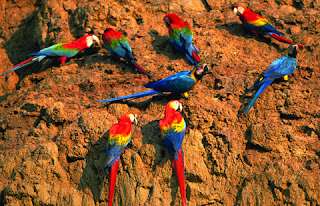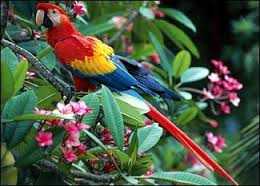Pieśni Parku Narodowego Manu i
tambopata zastrzeżone Strefie
Manu Park Narodowy jest
obszarem chronionym znajduje się w południowo-wschodnim Peru, częściowo
znajduje się w departamentach Cusco i Madre de Dios, w prowincjach Manu i
Paucartambo. To obszar 1,532,806 ha, podzielony jest na trzy główne obszary:
Parku Narodowego, z 1,155,806 ha; Reserved Zone, z 257 000 ha; i strefa martwa
i materiały kulturalne, z 120.000 ha. Usługi obejmują katalogowanie jako
rezerwat biosfery.
Reserved Strefa Tambopata -
Candamo, utworzony w 1990 roku, znajduje się na wschód i na południe od Puerto
Maldonado, ma powierzchnię 1,5 mln ha (3,5 mln akrów) w regionach Madre de Dios
i Puno.
W Manu i Tambopata są pewne
miejsca o szczególnych cechach, zwane Collpas, gdzie wiele gatunków stado papug
i innych papug łykać minerały, które uzupełniają swoją dietę.
Papugi (Psittacidae) to
rodzina ptaków powszechnie zwanych papugi papugowate lub papugi, w tym ary,
papugi i związanych z nimi form Ameryki i Afryki. Jest objęte nadrodziny
Psittacoidea z dwóch pozostałych rodzin typowych papugi: psittrichasiidae i
psittaculidae.
W "Lizać" to
nazwa keczua z miejsc, gdzie wiele gatunków zwierząt gromadzą jeść minerały
gleby. Naukowcy uważają, że zachowanie to uzupełnienie diety tych zwierząt.
Ponadto stwierdza się, że spożywanie gruntu zmniejsza toksyczne skutki
niektórych dzikich owoców i nasion. Szeroko akceptowane jest to teoria patrząc
sodu jako wybrane obszary mają wysoką zawartość minerału.
W lizać Manu, można
obserwować i fotografować setki papug średnich i dużych ary i czerwone i
zielone, które przychodzą w to miejsce do jedzenia. W miesiącach maju, czerwcu
i lipcu w lizać działalności gliny jest niższa niż w sierpniu i wrześniu.
W tambopata Reserve, jest
to duży lizać, glina, na lewym brzegu rzeki tambopata, znany na całym świecie
ze swojego spektakularnego i uważane za największe w peruwiańskiej Amazonii,
ponieważ nie zgadzam się wiele ary, papugi i papugi.
Istnieją również mniejsze
gliny lick w ara Heath rzeki. Chuncho lizać jest nisko położony wzdłuż klifu w
Tambopata dopływem, 5 godzin w górę rzeki od Puerto Maldonado. Colorado gliny
lizać jest godzina w górę od lizać Chuncho, jest urwisko wyższej wysokości.
Niektóre popularne gatunki
widziane w tych miejscach są niebieskie, zielone i złota ara, szkarłat,
czerwony i niebieski-headed papugi i papugi. Małpy, tapiry i kapibary, jelenie
są również często spotykane.
Codziennie rano w 6:00,
zadebiutował fruwające przed rozpoczęciem ceremonii "colpeo", który
składa się z przyjmowaniem gliny w wąwozie rzeki i po 25-30 minut usuwania Iran
wrócić następnego dnia. Były one również przestrzegać ary grupy w innym czasie,
ale nie tak bezpieczne i zazwyczaj są mniejsze grupy.
Suggested Links:
Referencje
MANU WILDLIFE CENTER
COLLPA DE GUACAMAYOS
Reserva
nacional Tambopata
Collpas
en el Rio Tambopata
Psittacidae





















































